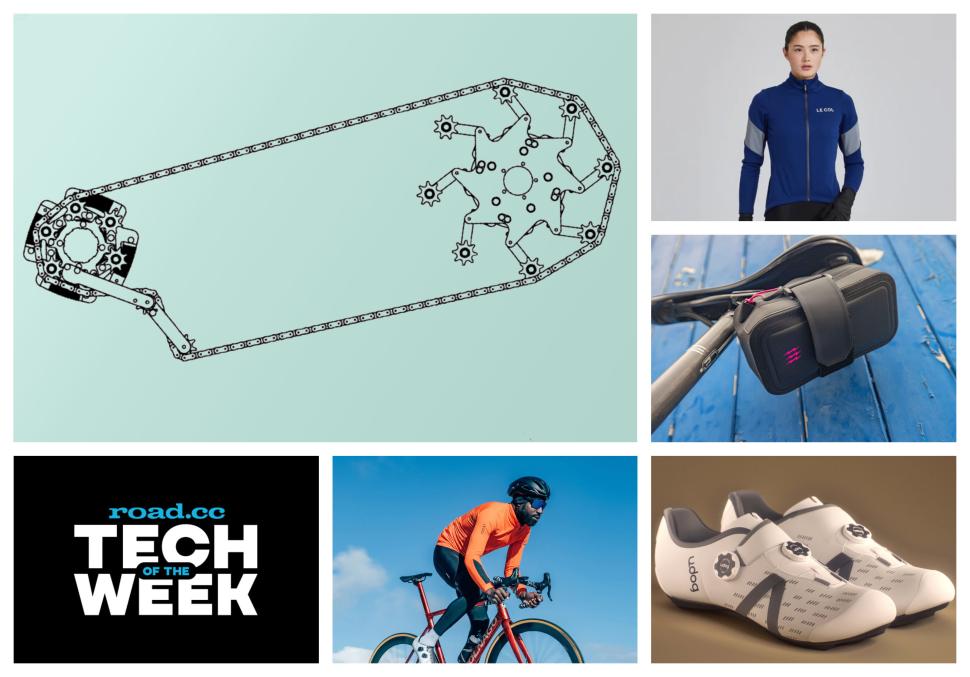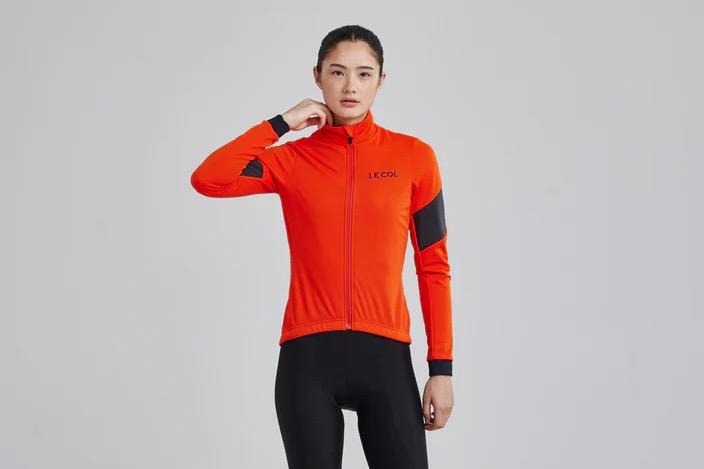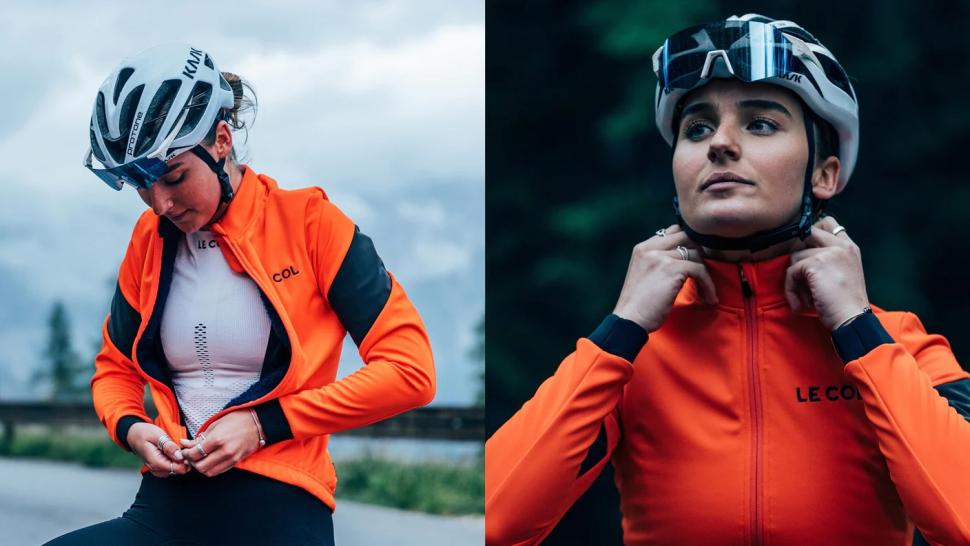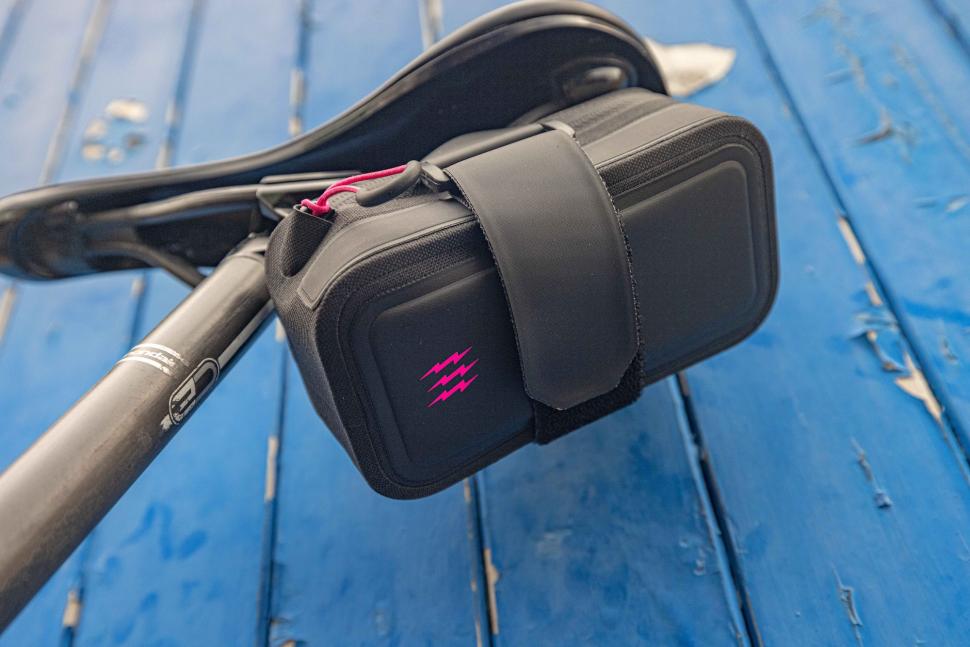- News
- Reviews
- Bikes
- Components
- Bar tape & grips
- Bottom brackets
- Brake & gear cables
- Brake & STI levers
- Brake pads & spares
- Brakes
- Cassettes & freewheels
- Chains
- Chainsets & chainrings
- Derailleurs - front
- Derailleurs - rear
- Forks
- Gear levers & shifters
- Groupsets
- Handlebars & extensions
- Headsets
- Hubs
- Inner tubes
- Pedals
- Quick releases & skewers
- Saddles
- Seatposts
- Stems
- Wheels
- Tyres
- Tubeless valves
- Accessories
- Accessories - misc
- Computer mounts
- Bags
- Bar ends
- Bike bags & cases
- Bottle cages
- Bottles
- Cameras
- Car racks
- Child seats
- Computers
- Glasses
- GPS units
- Helmets
- Lights - front
- Lights - rear
- Lights - sets
- Locks
- Mirrors
- Mudguards
- Racks
- Pumps & CO2 inflators
- Puncture kits
- Reflectives
- Smart watches
- Stands and racks
- Trailers
- Clothing
- Health, fitness and nutrition
- Tools and workshop
- Miscellaneous
- Buyers Guides
- Features
- Forum
- Recommends
- Podcast
TECH NEWS
 TotW-08-12-2023
TotW-08-12-2023Check out the most bizarre auto-shift drivetrain you’ll ever see, plus more tech news from Zwift, Cube, Le Col, Hiplok, Muc-Off, MAAP and more
We have loads of new stuff to tell you about from the likes of Zwift, Le Col, Cube and Hiplok, along with Udog’s first dial-closure shoes and MAAP’s latest collab, but we’re starting this edition of Tech of the Week with an auto-shifting drivetrain like you’ve never seen before…
Check out the most bizarre drivetrain you’ll ever see
Could a newly published patent that automatically adjusts the gear ratio as you cycle be the shape of things to come? Hmm, we’re guessing not, but this design from US company Innovative Engineering is certainly one of the most out-there we’ve ever seen.
Essentially, it’s a transmission system that’s “configured to automatically adjust a torque ratio in response to changing drive forces”. In other words, if you come to a hill and pedal harder, the gear will adjust itself. Automatically adjusting chainrings aren't a new idea at all, but this is a novel take on the concept.
The chain runs on sprockets positioned on short arms that can pivot. The pattern of the sprockets can expand and contract as you pedal.
When there are small or no drive forces applied, when you're putting little power through the pedals, springs keep the sprockets at the front of the system in a spread-out pattern. The opposite is true at the rear – spring force keeps the rear sprockets contracted. In a conventional system, that’s similar to having your chain on a large chainring at the front and a small sprocket on the cassette, so a high gear.
However, things change automatically as you increase the drive force….
The patent says, “FIG. 4 shows the automatic transmission in a state with sufficient drive forces acting upon it to partially compress the front mechanism and partially expand the rear mechanism to a point somewhere near the middle of their respective diametric ranges.
“FIG. 5 shows the automatic transmission in a state with sufficient drive forces acting upon it to fully compress the front mechanism and fully expand the rear mechanism, such as when a bicycle is being ridden uphill and the rider is applying a relatively high pedal force. This state corresponds to the lowest torque ratio that this embodiment of the invention offers and is comparable to the lowest gear of a traditional bicycle transmission.”
Get the gist? This is the crux of the design.
“As increasing drive forces are applied to the automatic transmission, the diameter of the front mechanism smoothly and continuously transitions from larger to smaller diameters while the diameter of the rear mechanism smoothly and continuously transitions from smaller to larger diameters.
“During use, as the drive forces increase or decrease and/or as the resistive forces increase or decrease, the diameters of the front mechanism and rear mechanism automatically and continuously adjust to the forces.
“In this way, the automatic transmission automatically adjusts to the forces such that no manual selection of gears is needed and the varying diameters of the front and rear mechanisms make it unnecessary to have multiple sizes of selectable sprockets.”
The patent gets way more in-depth than this – there are dampers to slow down automatic adjustment and all sorts – but this is the concise version of how it works. Read the original (it’s patent US 2023/0373592) for all the details.
You're wondering about sprinting, right? We're guessing the inventor is thinking about utility-type bikes rather than race machines. What do you reckon, though? Does it have legs or is this a level of complexity we don’t need? Let us know in the comments.
In other drivetrain news from a totally different source, check out this mesmerising video of belt drive shifting from Veer Cycle…
Belt drives don’t usually do this! You now know as much about it as we do, but we’ve dropped Veer Cycle a message to ask for more details. We’ll keep you updated.
Zwift introduces extra levels and new versions of virtual climbs
Zwift has announced a bunch of new features designed to improve its online riding experience… and looking at the UK weather right now, that couldn’t be more welcome.
For a start, there’s a new level structure.
“We’ve completely redesigned our cycling levels so that Zwifters can move up the ranks faster and ride all the way to level 100 instead of stopping at level 60,” says Zwift. “The number of XP [experience points] needed to progress at each level has been reduced so that Zwifters can progress through the game faster. At each level, Zwifters will be rewarded with a new jersey, bike, or accessory to unlock.”
> Check out our review of the Zwift Play controller
If you’re already at level 60, you can move up the ranks faster.
Zwift will also now reward you for consistent riding. Ride two or more times in a week, and you’ll get an extra bump in XP to level up faster.
For each of the first two Zwift rides of the first week of a streak, you’ll earn 300 XP. In the second week, you’ll earn 400 XP per ride. In week three, 500 XP is available for the first two rides. Keep the streak going beyond week three, and you’ll continue to earn 500 XP for as long as you keep it going.
> How to get started with Zwift
Finally, Zwift has updated the Climb Portal that was launched earlier in the year, challenging you to tackle virtual versions of real-world climbs.
Zwift says, “Zwifters can now choose from different versions of the climbs – a GPS-accurate 100% version, a monumental 125% version, or easier 50% and 75% versions.
“Each version of the climb will have its own leaderboard and will show Zwifters what percentile of climbers they’re in.
Zwift says it’ll continue to offer a Climb of the Month in the France Climb Portal and a rotating selection of climbs in the Watopia Portal. You can see a schedule of climbs here.
Have you ever been pulled over for cycling too fast?
Florida resident Troy Timmons reported on a velomobile Facebook group this week, “Just had an encounter with local law enforcement while riding my Bulk velomobile. Despite being designed for efficient commuting, I can’t help but treat it like my race bike. Today, I may have been a bit too ‘efficient', according to a super-nice officer who couldn't believe it wasn’t motorised. Got a friendly warning, a reminder to stay safe, and a story to share!”
If you’re unfamiliar, a velomobile is a fully-faired human-powered vehicle that you pedal. Think of it as a recumbent bike in a sleek, aero shell. These things really can shift on the flat.
Troy told us, “It was an interesting interaction. The officer stated that my speed initially caught his attention and that I closed the distance quickly on the car in front of me (drafting). He mentioned that he notified dispatch that he was making a traffic stop but didn’t know what he was pulling over. We both shared a laugh at that one.
“Once he pulled me over, he looked for a license plate/registration and was pleasantly surprised to find that I was riding a bicycle. He warned me to be safe, both in speed and while operating on the roadways. The officer even took pictures to share with his fellow officers.
“The officer was great, very understanding, and respectful. I thanked him profusely for his service to our community and refrained from asking any questions about how fast I was going or why he pulled me over.
“I live in a beautiful place almost perfect for TT runs and routinely have sub-four-hour centuries in the velomobile, despite being 57 years old and over 200lbs.”
It’s a whole other world, and if you think cyclists can get obsessive, just wait until you meet these guys…
Udog turns to dials on new Cento shoes
Italian cycle shoe brand Udog has unveiled a new model called Cento, its first with a dial closure. Up until now, all of Udog’s shoes have been laced.
Udog says, “This latest addition to the range incorporates the innovative new Udog Micro Twist dial. Its unique micro-adjusting rotor provides a uniform, customised fit for enhanced support and stability.”
> The birth of a new brand: UDOG shoes
The dial has a 30mm diameter and comes with a soft rubber edge that’s designed to improve grip. The lower one sits centrally on top of your foot.
Udog says, “The position of the front dial controls the volume of the forefoot area via the Udog patent system tensors. Like the previous Udog models Tensione and Distanza, Cento incorporates the Udog Tension Wrap System (TWS) in a new release called TWS 2.0.”
Check out the photo below and it’s pretty obvious how this closure system works. A picture paints a thousand words, and all that. Why does Udog go down this route?
“The centre-located Micro Twist applies even pressure to the integrated tensors with no pressure points on the upper. The TWS 2.0 system acts primarily across the independent tensors on a larger area of the shoe’s upper, pulling the eyelets inwards consistently from all directions for a more supportive and comfortable fit. Using textile lace guides further eliminates pressure hot spots.”
Check out our review of the Udog Tensione Pure Black Shoes
The Cento features a laser-perforated microfibre upper with TPU (thermoplastic polyurethane) reinforcement, and a stiff carbon composite outsole. Udog uses the same last as previously, with a roomy toe box and a deep heel cup.
Udog claims a weight of 270g per shoe in a size 42.
Designed for both men and women, the Cento is available in 11 sizes from 38 to 48, priced at £260. We'll be reviewing a pair soon.
You can pre-order now for delivery in March.
Le Col uses new plant-based Polartec Power Shield in autumn/winter clothing
British bike clothing brand Le Col is using Polartec’s new plant-based Power Shield fabric in its range for autumn and winter with the aim of improving sustainability.
Polartec says, “As the outdoor industry moves beyond PFAS and toward bio-based alternatives, Polartec Power Shield finally cracks the code on an eco-engineered weatherproof technology with absolutely no compromise in performance. The secret is a completely different membrane from the micro-porous, multi-layered Polartec membranes of the past, made with 48% non-food source, non-GMO plant-based bio-materials.”
> Find out about Polartec Power Shield here
Rather than micropores, Power Shield uses molecular diffusion to move water vapour out while stopping water droplets getting through. This type of technology isn’t new, but a membrane that can be layered within a technical fabric and cope with stretching, washing, and general abuse is.
> How green is your waterproof cycling jacket?
The latest versions of Le Col’s Hors Categorie Jacket II, Pro Jacket, Pro All Weather Jersey and Pro All Weather Gilet all feature Polartec Power Shield.
The Hors Categorie Jacket II (£330), for example, uses Power Shield alongside Polartec’s Alpha Active Insulation for warmth.
Hiplok confirms production of anti-angle grinder locks
Do you remember that last month we told you about Hiplok’s new 1000 Series of locks and anchors designed to safeguard bikes and motorcycles even from thieves armed with angle grinders? The UK brand launched a Kickstarter project that achieved its funding target within hours.
That campaign is now complete, and Hiplok has confirmed that production is underway, with the first deliveries scheduled for April 2024.
If you didn’t get on board via Kickstarter, you can now pre-order the 1000 Series products on Hiplok’s website.
The Hiplok A1000 anchor (above) is £179.99, for example, while the DX1000 D-lock (up there somewhere) – designed for larger-framed bikes and motorcycles – is £299.99. Not cheap… but then, neither is your bike.
Check out this tiny rechargeable bike pump
There are ever more titchy tiny rechargeable bike pumps out there these days, including the Cycplus Cube Mini Pump impressed Dave Atkinson in our review last week, and here’s another…
The Flextail Tiny Bike Pump features an aluminium housing, measures 69 x 41 x 28mm (so it’s a touch smaller than the Cycplus), and weighs a claimed 111g. It’s compatible with both Presta and Schrader valves.
Flextail says, “Tiny Bike Pump can inflate two 700C x 25mm tyres from 0 to 80psi with ease and reach a maximum pressure of 100psi. It's a reliable and powerful tool that can inflate a tyre to 80psi in just 80 seconds.”
It recharges via USB-C in 25 minutes and is priced at $99.99 (about £80), with free shipping to Europe, USA, Canada, Australia...
Baseus debuts new sweat-repellent earbuds
If you want earbuds that are capable of putting up with a bit of sweat, Baseus has just launched its new Bowie MA10 Bluetooth 5.3s, and they’re not too expensive.
Baseus says, “With an IPX6 waterproof rating, the earbuds effectively repel sweat and water, making them an ideal companion for workouts and outdoor adventures.”
IPX6 means that a product is capable of standing up to powerful water jets while IPX7, the next level up, covers immersion in water to a depth of a metre.
They offer active noise-canceling technology “that can automatically pick up and cancel 95% of ambient noise, [with a] noise-cancelling depth up to 48 decibels”.
Single-charge playtime is eight hours, and the total playtime with the charging case is a whopping 140 hours.
The Bowie MA10 earbuds are available for £35 from the Baseus website and should be available on Amazon UK soon.
Cube introduces new hip bag
If you’re still on the lookout for Christmas presents, Cube has introduced a new Vertex 3 hip bag that’s available in four colours: black, olive, light blue, and orange.
“With a wide, padded hip belt and ventilated back system, the Vertex 3 is perfect for safely transporting your ride essentials in comfort,” says Cube. “It packs plenty of practical features into a small space: front pockets with compartments, mini pockets on the belt, elasticated side pockets... All that in a three-litre hip bag.”
It offers hydration system compatibility too, and it’s yours for £69.95.
Muc-Off releases new saddle pack
Sticking with bags, Muc-Off has introduced a new saddle pack that’s made from 600D TPU material and features a water-resistant zipper to keep your stuff safe.
The saddle pack offers 0.7L of storage, which is enough for a spare inner tube, CO2 inflator kit, tyre levers, and multi-tool. It weighs 95g.
Reflective graphics are designed to improve visibility, and a hook-and-loop strap keeps the pack secure on your saddle rails.
Price? It’s £35.
Ride on time: MAAP announces limited-edition watch
Aussie bike clothing brand MAAP is branching out with a limited edition watch that'll be available next week.
Only 100 of the MAAP x Unimatic Modello Quattro UT4-T-M watches have been made, and they’ll be available to MAAP newsletter subscribers first.
“The MAAP x Unimatic Modello Quattro UT4-T-M is a modern military-style tool watch that delivers utilitarian function and a shared vision to merge aesthetics and performance,” says MAAP. “The technically advanced timepiece features a lightweight titanium casing with a 360° antishock protection quartz movement, a first for the Milan-based watch designer.”
A price hasn’t yet been announced.
In case you missed it earlier in the week…
- 1x vs 2x: Are single chainring set-ups the future of road cycling or just another marketing fad?
- Former F1 team owner Eddie Jordan launches e-bike brand
- Ford claims its new van can solve the issue of “cyclists getting doored” by drivers and passengers
- Does Garmin’s new Tacx Neo 3M trainer really offer “the most realistic indoor ride yet”?
- Enve bikes join pro peloton with Team TotalEnergies riding the Melee in 2024
- Cervélo’s first e-bike switches between road and gravel modes... and doesn't look much like an e-bike
- Strava introduces messaging - you can now communicate with your friends on the app
Mat has been in cycling media since 1996, on titles including BikeRadar, Total Bike, Total Mountain Bike, What Mountain Bike and Mountain Biking UK, and he has been editor of 220 Triathlon and Cycling Plus. Mat has been road.cc technical editor for over a decade, testing bikes, fettling the latest kit, and trying out the most up-to-the-minute clothing. He has won his category in Ironman UK 70.3 and finished on the podium in both marathons he has run. Mat is a Cambridge graduate who did a post-grad in magazine journalism, and he is a winner of the Cycling Media Award for Specialist Online Writer. Now over 50, he's riding road and gravel bikes most days for fun and fitness rather than training for competitions.
Latest Comments
- wtjs 1 hour 32 min ago
That one seems so stupid and terminally illiterate, it must be an ironic spoof account
- ubercurmudgeon 1 hour 43 min ago
Even a stopped clock, etc, etc...
- Bigtwin 2 hours 59 min ago
How the actual F can you NOT go to prision for drinking vodka WHILE DRIVING A CAR!!??
- Bigtwin 3 hours 4 min ago
I wouldn't be meeting that Orange Pillock anywhere, let alone 1/2 way.
- Laz 3 hours 20 min ago
If the local police is unwilling or unable to do their job properly, then perhaps her insurance provider ought to re-evaluate the risks she poses...
- No Skinny Tyres 4 hours 59 min ago
It's a stabiliser, it was first used in WW2 to preserve chocolate in US rations. It allows the milk solids to fully dissolve, US chocolate is less...
- Martin1857 14 hours 14 min ago
As a member of the Co-op community (I live in a Housing Co-op) and a bike owner /rider, this is very sad news. We need more Co-ops not less.
- Dnnnnnn 14 hours 5 min ago
It is sad for the individuals concerned but (and this is a general point, rather than specific to this story), we're much better off overall for...
- No Reply 14 hours 56 min ago
I agree with Pogacar regarding social media. The likes of Facebook, Instagram have done untold damage, especially to the minds of young people....
- David9694 15 hours 1 min ago
Lorry carrying 25 tonnes of beer catches fire on the M11...





















Add new comment
12 comments
Another Brexit Bonus!
Try to order those Baseus headphones advertised and you find they don't send to the UK
That automatic chainset is very similar to one I saw a (single page) pamphlet for in the 1980s.
The one I saw, I think had non-contiguous bits of chain ring that moved in and out, instead of tiny sprockets, but other than that (and my terrible memory) pretty similar.
I can't remember any more about it, or if they ever made it past (or even to!) prototype stage.
Are you thinking of the 1983 Deal Drive? I can remember it being talked about in the press as very expensive and heavy, never saw one in the wild. They did go into production but were withdrawn after a couple of years.
Contemporary reference to the Deal Drive (pdf)
The point of gears on a bicycle is that you can adjust the speed of the bike without adjusting your power at a given cadence, e.g. when I get to a hill I can change down a few gears so that I don't have to massively up my power output to climb the hill.
This automatic system appears to achieve the exact opposite.
I have been waiting for the slightly larger angle grinder resistant hiplock, 3 inch tyres and I'd want to get frame rim and tyres attaching to the solid object. The original one only had a 3 inch internal width.
CUK members can get a 20% discount.
I'd be surprised if the US firm can get a patent on that automatic gear system. One using exactly the same principle was demonstrated on Tomorrow's World back in the 1980s. The system didn't go anywhere then because it was fairly heavy.
I'm glad you posted this, because I was reading it thinking "Didn't I see this on Tomorrow's World?". I wondered why it had never appeared - I assumed it was too expensive, too unreliable, or just poorly marketed.
Those trousers you can get with chainsaw protection, a layer of threads that instantly tangle and bind the motor - why don't they make a D Lock with some of that stuff under the rubber coating to bind up the angle grinder?
Because chainsaw teeth are very different to angle grinder blades?
See how well your chainsaw works on a steel bar, then try your metal cutting disc on a tree branch. Then you may be able to think clearly about those "threads".
MAAP watch, so people know you're a c*ck off the bike as well as on it.
Bit harsh!